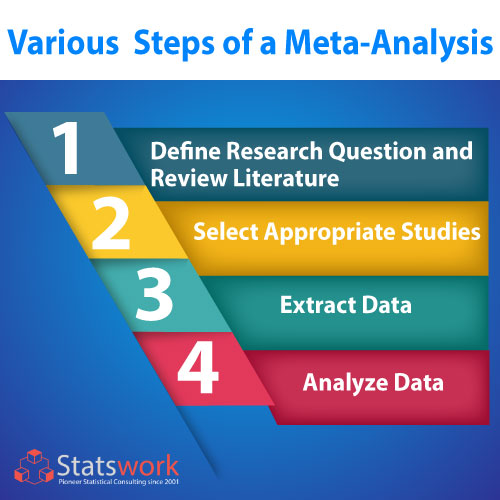Guideline for conducting Metadata analysis for Market research in business
In-Brief
- Meta-analysis is the systematic analysis of data from independent primary research focusing on the same question to generate a quantitative estimation of the studied phenomenon, such as intervention effectiveness.
- Meta-Analysis in Medical Research determining the intensity of the evidence for a disease or treatment.
- One of its goal is to see whether there is an impact; another is to see whether the consequence is positive or negative, and, ideally, to provide a single summary estimate of the effect.
Introduction:
A subset of systematic reviews is a tool for systematically integrating relevant qualitative and quantitative research data from many studies to develop a single conclusion with greater statistical power. Because of the larger number of subjects, greater diversity among subjects, or cumulative effects and outcomes, this conclusion is statistically more robust than any single study’s review.
The meta-analysis used for the following purposes:
- To provide a more complex study of harms, safety data, and benefits to create a more reliable estimation of effect magnitude.
- To determine statistical significance in studies with contradictory findings
- To look at subgroups of non-statistically important individual numbers
If the individual studies used randomized controlled trials (RCT), integrating the findings of many selected RCTs would be the highest level of evidence on the evidence hierarchy, followed by systematic reviews, which examine all available studies on a topic.
Advantages of mete data analysis
- It provides much greater statistical power.
- It helps in confirmatory data analysis.
- Capability to generalize the solution to the general population affected.
Disadvantages of metadata analysis
- Finding suitable studies is difficult and time-consuming.
- Specialized statistical techniques are needed since not all studies have sufficient data for inclusion and analysis.
- The research populations’ heterogeneity
What Is a Meta-Analysis?
There are various ways in which a particular study can be summarized to support healthcare workers in making significant decisions. It also involves narrative reviews, Meta-Analysis and Systematic Review. The narrative and systematic reviews both are qualitative. Meta Data Analysis Online help in gathering data, about medical patient which help in finding solution for various healthcare problems.
Narrative reviews: It focuses on fundamental and essential topics and is not very rigorous.
Systematic reviews: They are more thorough than narrative analyses because they concentrate on a single research topic. A systematic analysis, for example, would concentrate on the connection between cervical cancer and long-term use of oral contraceptives, while a narrative review will focus on cervical cancer.
Meta-analyses: are quantitative and more rigorous than both types of reviews. In addition to providing an overview, these papers provide a quantitative assessment of how well a treatment works. They may also provide an estimate of how much more likely a person is to develop a disease if they participate in certain behaviour.
Why Do a Meta-Analysis?
Medical research can be confusing. How would you decide if you read 30 studies that said a weight loss treatment worked and 30 that said it did not work? What if there was a better way than just flipping a coin? The reason people do meta-analyses is that research from several studies with conflicting results can be combined to make decisions about the effectiveness of a medication on a person’s risks for developing a disease that is more informed than using a Magic 8-ball.
Meta-analysis is a quantitative, structured, epidemiological study design for systematically evaluating previous research outcomes to conclude the body of work. The research mainly focuses on clinical trials. Meta-Analysis in Clinical Trials helps to assess the strength of evidence present on disease and treatment.

The Steps of a Meta-Analysis
1. Define Research Question and Review Literature
The primary step in a meta-analysis is to define the research issue. A well-defined research question describes the population impacted by the intervention and the treatment’s possible outcome(s). For instance, Are women who have used oral contraceptives for ten years or have a high risk of getting cervical cancer than women who have never used them? This question recognizes cervical cancer as a result of the intervention, long-term contraceptive use, and it describes the population.
After you have identified your research query, you will want to look through the literature for studies that address it. When you scan the literature, it is like searching for facts on Google, except you’re looking in places like PubMed, Medline, EMBASE, or Google Scholar instead of Google. You will be searching for scholarly papers that are important to your research question during this process.
2. Select Appropriate Studies
The most crucial step in a meta-analysis is selecting the relevant studies. The studies are chosen for inclusion to strengthen the study. There is no set procedure for selecting papers, but duplicates, papers written in a language you don’t understand, and papers which does not belong to clinical studies excluded.
After you’ve ruled out any useless papers, go through the rest of the papers again for eligibility. Several factors used to decide whether a paper is eligible for review, but all of the research you use must have the data you need to complete your analysis. This data may include demographics such as age, ethnicity, health status, and statistical analyses.
3. Extract data
Extraction of data for analysis and synthesis is the next step in the process. This part of the process is made simpler by using a spreadsheet, table, or another method to record the data. The data which is collected depends on the research issue. Still, it may include sample size, patient characteristics, study duration, and a statistical measure like a confidence interval, odds ratio, risk ratio, mean difference, or hazard ratio.
4. Analyze data
Once you have arranged it, you will need to use statistical tools to analyze it. You can compare statistical differences between groups using a forest plot. The statistical measure we used in our example was a relative risk, which indicates the risk differential between groups. It will enable researchers to determine whether long-term oral contraceptive users are more likely to develop cervical cancer.
Conclusion
Meta-Analysis in Statistics brings together the findings of many scientific studies. When there are several research studies asking the same topic, and each study reports measurements that are supposed to have some degree of error, a meta-analysis may be performed. If you face difficulty with meta-analysis you can get help from experts or can Hire a Meta-Analysis Expert who has experience in particular field.
References
- L’ABBÉ, K. A., Detsky, A. S., & O’ROURKE, K. E. I. T. H. (1987). Meta-analysis in clinical research. Annals of internal medicine, 107(2), 224-233.
- Hedges, L. V., & Olkin, I. (2014). Statistical methods for meta-analysis. Academic press.

 Next Post
Next Post